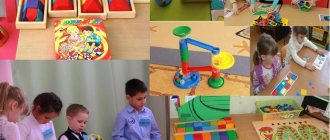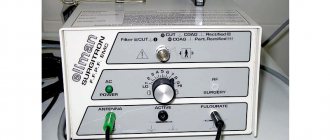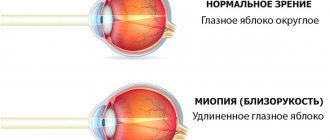- Causes of anxiety in children
- Difficulties in diagnosis
- Basic techniques
- Instructions for testing using the “Locomotive” technique as an example
The presence of disturbing conditions in children at an early age is a problem for many parents. The situation is complicated by the difficulties of identifying, assessing and interpreting the baby’s emotional state. To make the task easier, a large number of different techniques have been developed, among which gaming techniques occupy a special place. Thus, the Locomotive technique for identifying anxiety in preschoolers uses visual sampling of colors that are associated with a certain mood.
Causes of anxiety in children
Anxiety is a common phenomenon for many children. It is formed as a mental reaction of the body to any uncertainty, the unknown of the future. For a preschooler studying and getting to know this world, there are a lot of unknown factors, so the likelihood of developing anxiety is high.
Adults, especially parents, play a major role in the formation of disturbing conditions in children. Babies depend on mom and dad for everything. The degree of confidence depends on the behavior and attitude of adults.
Factors that increase the likelihood of developing anxiety:
- criticism and reproaches;
- comparison with children;
- lack of support;
- instability in daily life;
- misunderstanding of current events;
- low degree of parental involvement in the child’s daily life;
- performing actions that cause fear, anxiety, negative emotions;
- lack of love, attention.
These Children: developmental psychology, development and upbringing of children.
Goal: Determine the child’s anxiety level. Experimental material
: 14 drawings (8.5×11 cm) made in two versions: for a girl (the picture shows a girl) and for a boy (the picture shows a boy). Each drawing represents some typical situation in a child’s life. The child's face is not drawn in the drawing, only the outline of the head is given. Each drawing is accompanied by two additional drawings of a child's head, sized exactly to match the contour of the face in the drawing. One of the additional drawings shows a smiling face of a child, the other a sad one.
Conducting research
: The drawings are shown to the child in a strictly listed order, one after another. The conversation takes place in a separate room. After presenting the child with the drawing, the researcher gives instructions.
Instructions
.
- Playing with younger children. “What kind of face do you think the child will have: happy or sad? He (she) plays with the kids"
- Child and mother with baby. “What kind of face do you think this child will have: sad or happy? He (she) is walking with his mother and baby"
- Object of aggression. “What kind of face do you think this child will have: happy or sad?”
- Dressing. “What kind of face do you think this child will have, sad or happy? He (she) gets dressed"
- Playing with older children. “What kind of face do you think this child will have: happy or sad? He (she) plays with older children"
- Going to bed alone. “What kind of face do you think this child will have: sad or happy? He (she) is going to bed."
- Washing. “What kind of face do you think this child will have: happy or sad? He (she) is in the bathroom"
- Rebuke. “What kind of face do you think this child will have: sad or happy?”
- Ignoring. “What kind of face do you think this baby will have: happy or sad?”
- Aggressive attack “What kind of face do you think this child will have: sad or happy?”
- Collecting toys. “What kind of face do you think this child will have: happy or sad? He (she) puts away the toys"
- Insulation. “What kind of face do you think this child will have: sad or happy?”
- Child with parents. “What kind of face do you think this child will have: happy or sad? He (she) is with his mom and dad"
- Eating alone. “What kind of face do you think this child will have: sad or happy? He (she) eats.”
To avoid forcing choices on the child, the name of the person alternates in the instructions.
The child is not asked additional questions. The child’s choice of the appropriate person and the child’s verbal statements can be recorded in a special protocol (forms must be prepared in advance).
Sample protocol
:
Name: Nikolay Age: 6 years Date: 11/10/96
| Drawing | Statement | Choice | |
| Cheerful face | Sad face | ||
| 1. Playing with younger children | He's tired of playing | + | |
| 2. Child and mother with baby | Walks with mom, I like to walk with mom | + | |
| 3. Object of aggression | I want to hit him with a chair. He has a sad face | + | |
| 4. Dressing | He will go for a walk. Gotta get dressed | + | |
| 5. Playing with older children | Because he has children | + | |
| 6. Going to bed alone | I always take a toy to bed | + | |
| 7. Washing | Because he washes his face | + | |
| 8. Reprimand | Mom wants to leave him | + | |
| 9. Ignoring | Because there's a baby | + | |
| 10. Aggressiveness | Because someone is taking away the toy | + | |
| 11. Collecting toys | Mom forces him, but he doesn't want to | + | |
| 12. Isolation | They don't want to play with him | + | |
| 13. Child with parents | Mom and dad walk with him | + | |
| 14. Eating alone | Drinks milk and I love thread milk | + | |
Analysis of results: The protocols of each child are subjected to quantitative and qualitative analysis.
Quantitative Analysis
Based on the protocol data, the child’s anxiety index (IT) is calculated, which is equal to the percentage of the number of emotionally negative choices (sad face) to the total number of drawings (14):
| IT = | Number of emotional negative choices | x100% |
| 14 |
Depending on the level of the anxiety index, children are divided into 3 groups:
a) high level of anxiety (IT above 50%); b) average level of anxiety (IT from 20 to 50%); c) low level of anxiety (IT from 0 to 20%).
Qualitative analysis
Each child's answer is analyzed separately. Conclusions are drawn regarding the possible nature of the child’s emotional experience in this (and similar) situations. Fig. has a particularly high projective value. 4 (“Getting Dressed”), 6 (“Going to Bed Alone”), 14 (“Eating Alone”). Children who make negative emotional choices in these situations are likely to have high IT; children making negative emotional choices in the situations depicted in Fig. 2 (“Child and mother with baby”), 7 (“Washing”), 9 (“Ignoring”) and 11 (“Picking up toys”) are more likely to have high or moderate IT.
As a rule, the highest level of anxiety manifests itself in situations that model the child-child relationship (“Playing with younger children”, “Object of aggression”, “Playing with older children”, “Aggressive attack”, “Isolation”). The level of anxiety is significantly lower in drawings modeling child-adult relationships (“Child and mother with baby”, “Reprimand”, “Ignoring”, “Child with parents”), and in situations modeling everyday actions (“Dressing”, “Laying to bed”) sleeping alone”, “Washing”, “Gathering toys”, “Eating alone”).
Stimulus material for the anxiety test (R. Templeple, V. Amen, M. Dorki)
Pictures for the test for girls:
Pictures for the test for boys:
We also recommend other methods for studying children's anxiety: Methodology for identifying children's fears “Fears in houses” |
Child's anxiety level | Diagnosis of the level of school anxiety for primary and secondary schoolchildren. Tags: tests testing child anxiety Amen
Difficulties in diagnosis
Determining the degree of anxiety in preschoolers and junior schoolchildren is complicated by age-related characteristics. The child poorly understands and does not control the processes that occur in his mental and emotional world. He is unable to independently identify deviations from the norm in the perception of reality.
The primary way to diagnose anxiety is to identify behavioral patterns. Based on behavioral signs, one can identify the presence of disturbing conditions.
Signs of an anxious child:
- fussiness;
- motor restlessness;
- repetitive movements - thumb sucking, hair twirling, nail biting;
- sleep disorders;
- stiffness;
- panic fear of the new, of any change;
- diffidence;
- refusal of new activities;
- seriousness;
- reluctance to stand out and desire for silence;
- frequent fears for no reason;
- low self-esteem.
Based on primary signs, adults are able to determine deviations in the emotional state of a child, but to accurately diagnose anxiety and assess the degree of its manifestation, it is necessary to use special techniques.
Validation
Since the Multidimensional Assessment of Child Anxiety Questionnaire consists of 10 independent scales, the validity of each scale was determined independently. The validity of the questionnaire as a whole was determined qualitatively by the totality of the validity of these 10 scales. The main emphasis was placed on assessing content and criterion validity.
Content validity
Content validity (internal) was confirmed by the opinion of a group of qualified experts who analyzed the general structure of the questionnaire scales and the content of questions related to each of the 10 scales. The experts came to the conclusion that the content of the questionnaire corresponds to the modern description of the phenomenon of anxiety and its specificity in children and adolescents.
Construct (conceptual) validity
Within the framework of general content validity, the construct (conceptual) validity of the multidimensional assessment of children's anxiety was studied. In the process of creating the questionnaire, it was assumed that the nature of anxiety in children and adolescents could be determined by various factors, i.e. The actual specific manifestations of anxiety in a child or adolescent often do not correspond to those in adults and largely depend not only on the age, but also on the gender of the child, the characteristics of the social situation of his development, as well as on his personal characteristics and psychophysiological characteristics. This concept, which implies the need for a multidimensional characterization of anxiety in children and adolescents, was embodied in the design of 10 scales of the questionnaire. Each of these scales reflects the value of a factor common to all scales - anxiety, and the value of another anxiety factor, individual and specific for each scale of the questionnaire for the multidimensional assessment of childhood anxiety. This design of the questionnaire substantiates its constructive (conceptual) validity. Based on the above, within the framework of the construct validity of the questionnaire, validity based on age differentiation can be indicated.
Differential-age validity
Validity for age differentiation was determined by the possibility of using this questionnaire for different age groups of subjects. To assess the adequacy of the wording of the questions of the multidimensional assessment of childhood anxiety questionnaire for the purpose of using them for diagnostic purposes in a wide range of age groups of children and adolescents (from 7 to 18 years old), a special analysis was carried out with the participation of a group of experts (children 5-7 years old and adolescents 16-18 years) as a result of which, only those questions were selected that, on the one hand, would not cause misunderstanding of their meaning among children of primary school age, on the other hand, would be adequately perceived and would not cause resistance, as “stupid”, among older schoolchildren.
In addition, the empirical procedure for standardizing the research results obtained using the method of multidimensional assessment of childhood anxiety by one-way analysis of variance (ANOVA) revealed the influence of gender and age on the values of the scale indicators, which led to the need to take into account differences by gender and age. Thus, based on the results of the obtained reliable statistical differences, standards were specially developed to assess the severity of each of the 10 indicators of the MODT questionnaire in accordance with the following age and sex groups: 7-10 years (junior school age), 11-12 (pre-pubertal age) , 13-15 (puberty), 15-18 years (adolescence). Of particular note is the fact that the empirically developed approach to the use and evaluation of results turned out to be justified from a theoretical point of view, since it is consistent with the periodization of mental development accepted in our country.
Criterion validity
The procedure carried out to confirm criterion-related validity (criterion validity) consisted of establishing empirical measures of correspondence between the assessments of the questionnaire for a multidimensional assessment of children's anxiety and criteria external to it, which quite objectively, substantiated and reliably characterize anxiety in children and adolescents. In the framework of the study of criterion validity, we distinguished its two main types: consensus
and
empirical.
In our case, consensus validity established a measure of agreement between the results of the questionnaire and criteria external to the questionnaire.
Such criteria were self-assessments of children and adolescents, as well as assessments by parents and teachers of the severity of emotional manifestations in the behavior of children, indicating the presence of anxiety. Criterion 1.
Self-assessment of the psycho-emotional state of children and adolescents associated with anxiety.
A comparison of data from a questionnaire for multidimensional assessment of childhood anxiety with characteristics of self-esteem was carried out on a sample of 413 children and adolescents aged 9 to 17 years. Positive correlations were found (at p<0.05) between the indicators of the corresponding scales of the MODT questionnaire and the problematic relationships that children noted with their peers (r=0.23), parents (r=0.32) and teachers (r=0.28). ). In addition, the severity of the indicator of the multidimensional assessment scale of childhood anxiety, reflecting an increase in autonomic reactivity caused by anxiety, was significantly (p < 0.05) associated with the presence of disturbing health problems indicated by children and adolescents in self-assessment (r = 0.20). Against this background, the interdependence of the indicators of most scales with self-reported problems related to academic performance (r = 0.30) may support the assumption that these problems are most often the cause of anxiety in children aged 9 to 17 years. This, in turn, is consistent with the concept of the leading type of activity of a given age. Criterion 2.
Parents' assessment of children's emotional and behavioral characteristics associated with anxiety.
Parents' assessments of children's behavioral characteristics were also compared with data from a multidimensional assessment of children's anxiety in a sample of 180 families of children and adolescents aged 7 to 18 years. The indicators of all scales of the questionnaire for the multidimensional assessment of children's anxiety positively correlate (at p<0.05) with assessments of the emotional and behavioral characteristics of children associated with sleep disorders, the presence of fears and other characteristics of the anxious reaction of children noted by their parents at home (r=0.29) . In addition, three scales of the questionnaire are identified separately (“General anxiety” (r = 0.35), “Decreased mental activity caused by anxiety” (r = 0.28), “Increased autonomic reactivity caused by anxiety” (r = 0. 26)), the indicators of which are interconnected with all indicators of violations in the emotional and behavioral sphere of children noted by parents at home. Criterion 3.
Teachers' assessment of children's emotional and behavioral characteristics associated with anxiety. A comparison of the questionnaire data with teacher assessments of the emotional and behavioral characteristics of children and adolescents was carried out on a sample of 443 schoolchildren aged 7 to 17 years. Thus, almost all indicators of the questionnaire scales significantly (p<0.05) positively correlate with teacher assessments such as the child’s ability to concentrate on a task, his level of distractibility in class, the frequency of the need for additional control and individual detailed explanations of the material by the teacher (r=0.30 ). In addition, correlations were identified (at p<0.05) for indicators of such scales of the multidimensional assessment of childhood anxiety questionnaire as “Anxiety in relationships with peers” (r=0.26) and “Anxiety associated with educational success” (r=0. 30) with the majority of teacher assessments indicating certain deviations of children in the emotional and behavioral sphere.
These are the results of the analysis of the relationship between the questionnaire for multidimensional assessment of children's anxiety and expert assessments of anxiety in children and adolescents external to this test. These results support the consensus validity of the Multidimensional Childhood Anxiety Questionnaire.
The procedure for testing empirical validity established a measure of compliance by calculating correlation coefficients between the results of the questionnaire for the multidimensional assessment of childhood anxiety and criteria external to this questionnaire, which were assessments of other tests that reveal the presence of anxiety and emotional-behavioral phenomena associated with it. To establish the empirical validity of the questionnaire for multidimensional assessment of children's anxiety, the results of the study were used: the children's version of the Cattell questionnaire, the Individual Typological Children's Questionnaire (ITChI), the Method of Color Choices (MCV), and the Pathocharacterological Diagnostic Questionnaire for Adolescents (PAQ).
The children's version of the Cattell Questionnaire was used on a sample of 227 children aged 7 to 12 years, and evidence was obtained for the empirical validity of a multidimensional assessment of childhood anxiety. It was revealed that all indicators of the questionnaire scales are positively correlated at p<0.05 with such indicators of the Cattell questionnaire, indicating the presence of anxiety in the structure of personal properties, such as – –C “unconfident, easily vulnerable, emotionally unstable”) (r=0 .56), –N (“timid, shy, sensitive to threat”) (r=0.48), +O (“anxious, preoccupied, full of dark fears”) (r=0.47).
The “Individual Typological Children's Questionnaire” (ITChI) was used on a sample of 402 schoolchildren aged 9 to 17 years; evidence of the criterion validity of the multidimensional assessment of children's anxiety was also obtained. Reliably positive correlations were revealed between all indicators of the questionnaire and indicators of such scales of the individual typological children's questionnaire as “Anxiety” (the level of manifestations of anxiety, suspiciousness, timidity, a tendency to obsessive fears and panic reactions) (r = 0.39) and “Sensitivity” (level of sensitivity, focus on the authority of a stronger personality, conformity, manifestation of dependence traits in the personality structure) (r=0.26).
The Color Choice Method (CMM) was used on a sample of 66 children aged 7 to 12 years. A positive relationship was found (at p<0.05) with such questionnaire scales as “Anxiety in relationships with parents” (r=0.25) and “Decreased mental activity caused by anxiety” (r=0.24) with the indicator of the level of “anxiety” using the method of color choices, which characterizes the presence and intensity of emotional tension in the current state.
The Pathocharacterological Diagnostic Questionnaire for Adolescents (PAQ), which allows assessing the characteristics of the relationship between individual characterological characteristics of a teenager associated with manifestations of anxiety, was used on a sample of 315 adolescents aged 12 to 18 years. The indicators of most scales of the questionnaire turned out to be associated (at p<0.05) with such characterological manifestations as – sensitivity, characterized by increased sensitivity, impressionability, and a sense of inferiority (r=0.46); asthenic-neuroticism, reflecting the likelihood of developing anxiety reactions to changes in usual circumstances (r = 0.37) and psychasthenicity, characterizing the teenager as indecisive, unsure of himself, and anxiously suspicious (r = 0.36).
As can be seen from the above, the identified statistically significant correlations of the scale ratings of the questionnaire for assessing children's anxiety and the indicators of four other tests reflecting the anxiety of children and adolescents can serve as a sufficient basis for the validity of the statement about the empirical validity of the questionnaire. In general, the analysis of the questionnaire and the psychodiagnostic results obtained with its help confirm its content and criterion validity. In other words, we can state with a fair degree of confidence that the questionnaire for assessing childhood anxiety is a reliable, constructively and content-wise psychometric tool that allows for a multidimensional assessment of the characteristics of anxiety in school-age children and adolescents, which are significant for medical, psychological and pedagogical practice.
Basic techniques
To determine the presence of disturbing conditions in children of preschool and primary school age, a large number of various methods have been developed:
- "Ladder". The method is aimed at determining the level of self-esteem of a preschooler, how he sees the attitude of peers, parents, and adults towards him. The child’s attitude is very closely related to the disturbing conditions that haunt him. To carry out you need: a sheet of paper, cardboard, pencil, scissors. A ladder with seven steps is drawn on the sheet. The steps are the same, except for the third, which is wider. A human figure is drawn and cut out on cardboard. The child is asked to place the figurine on a specific step. The figures represent the child himself, the teacher, the educator, and other good and bad guys. The level of self-esteem is determined by the placement of the figurine on the step. The technique is used in diagnosing anxiety. It allows you to determine the impact on disturbing states of self-esteem and relationships with other people.
- Test "Fears in houses". Two houses are drawn on the sheet. The child is given a task: the “scary” and “non-scary” fears need to be distributed among the houses. Read 29 fears. The kid distributes them into houses. Based on sorting, objects that cause fear and anxiety in the child are determined.
- Choose the right person. The preschooler is asked to look at 14 pictures depicting various situations from a child’s life. The pictures show a baby with a face that is not drawn. The tested child needs to choose a “happy” or “sad” face that he associates with the situation in the picture. Based on the baby’s reaction to specific situations, the presence of anxiety and the sources of its development are determined.
- "Drawing of a Man." Materials needed: a sheet of paper and a pencil. The child is given the task of drawing a person without specifications, comments or explanations. When the figure is drawn, the child is asked who he drew. The drawing is analyzed, and the presence of anxiety in the baby is determined by the bright details.
- "Lamb in a Bottle" The technique is aimed at diagnosing the child’s psychological self-perception in the family. Materials: two sheets of paper and a pencil. On one sheet of paper, the child draws a lamb in a bottle. On the second sheet, you need to write down how the lamb feels, what he dreams about, what worries him. If the child does not know how to write, he is asked to answer these statements about the lamb. Based on the drawing and answers, the baby’s condition, the presence of anxiety, and the characteristics of its expression are determined.
- "Draw your fear." The child is asked to draw his fears on a piece of paper. After completing the task, the child is asked to comment on the drawing. Based on the drawing and answers, the objects of the child’s anxiety are determined.
- "Non-existent animal." The child is asked to draw a non-existent animal and give it a name. The child is asked to tell about the animal, what he loves, his fears and worries. Based on the drawing and answers, an idea of the disturbing conditions is formed.
- "Cactus". A test to determine the child’s emotional state, the presence of aggressiveness, and its direction. The child is asked to draw a cactus. After completing the drawing, a conversation is held with the child aimed at clarifying the details of the drawing. Based on the drawing and answers, an emotional portrait of the baby is drawn up.
- "Locomotive".
A special feature of the methods for children is their presentation in the form of manifestations that are understandable and natural for children - playing, drawing, composing a complex object from simple parts, etc.
In some cases, they are also used for teenagers.
Theoretical basis
Currently, there are many formalized methods for diagnosing anxiety and anxiety in children and adolescents. However, none of them allows us to consider these phenomena as multidimensional mental formations, identifying not only affective, but also other components that play an important role in the diagnosis of mental maladaptation. In addition, the lack of a unified psychodiagnostic approach to the assessment of childhood anxiety in different age groups, based on the principles and specifics of periodization of development in childhood and adolescence, greatly complicates the possibility of objective dynamic observation of the phenomena being studied, primarily in a comparative aspect. In this regard, in the laboratory of clinical psychology, a special psychological method was developed for the multidimensional assessment of childhood anxiety, which meets modern psychometric criteria, the results of which reflect not only the level and nature of anxiety in children and adolescents of school age (8-18 years old), but also the maximum possible range of situations in which it can be implemented.
When creating the questionnaire, the task of taking into account not only ontogenetic patterns and specific manifestations of anxiety, but also the requests of practitioners was solved. The procedure for constructing the methodology included several stages. At the first stage, the task of determining the range of possible manifestations of the phenomenon of anxiety in children and adolescents of school age was solved in order to create a theoretical construct for the future questionnaire. In accordance with this, based on the analysis of literature data and with the assistance of highly qualified specialists (psychologists, teachers, doctors) who acted as experts, the most informative parameters for assessing emotional and behavioral disorders of the anxiety register in children and adolescents of this age category were identified thematically. As a result, based on the characteristics obtained by experts, the corresponding names of the scales were formulated and their psychological content was revealed.
The psychodiagnostic structure of the multidimensional assessment developed in this way included 10 parameters-scales that make it possible to give a differentiated assessment of anxiety in children and adolescents aged 7 to 18 years. Based on the results obtained on these 10 scales, it was possible to obtain information about the structural features of anxiety in a particular child or adolescent in four main areas of psychological analysis:
- assessment of anxiety levels that are directly related to the child’s personal characteristics (scales 1, 3 and 7);
- assessing the characteristics of the child’s psychophysiological and psychovegetative anxiety response in stressful situations (scales 9 and 10).
- assessing the role of the characteristics of his social contacts (in particular, with peers, teachers and parents) in the development of the child’s anxious reactions and states (scales 2, 4 and 5, respectively);
- assessing the role of school-related situations in the development of anxiety reactions and states of the child (scales 6 and 8)
At the next stage, in accordance with the psychological content of each of the 10 declared structural elements (scales), 10 groups of questions were compiled, reflecting the psychological specifics of each of them. In total, about 250 questions were formulated at the initial stage. The further formation of the list of questions in the methodology was multi-stage and at each of these stages a special adjustment was made aimed at increasing the diagnostic and informative significance of the selected questions.
Thus, with the assistance of a group of experts (highly qualified clinical psychologists, teachers and doctors working with children and adolescents), the compliance of the content of the questions with the stated topics of the scales was assessed. As a result, 131 questions were selected (from 10 to 17 for each of the proposed diagnostic parameters). Further, to assess the adequacy of the formulation of questions for the purpose of using them for diagnostic purposes in a wide range of age groups of children and adolescents (from 7 to 18 years), the following procedures were sequentially carried out.
The conceptual assessment of the content of the questions and the adequacy of their formulations to the peculiarities of perception of younger children were assessed by a group of experts - students of preparatory and first grades of secondary schools (children 6-7 years old and adolescents 16-18 years old). The above-mentioned “experts” were offered the previously developed and selected questions in the form of an interview, during which these questions were subject to significant correction in terms of wording. In the process of this work, the questions gradually acquired a meaning accessible to the perception of respondents, by their age, obviously beyond the age limits of the initially intended area of application of this questionnaire. After that, an additional study was conducted on 470 schoolchildren in both primary and graduate classes of secondary schools, which confirmed the initial hypothesis regarding the possibility of using a single list of questions regarding anxiety manifestations for children and adolescents aged 7-18 years. The questions selected in this way, on the one hand, did not cause misunderstanding of their meaning among children of primary school age, on the other hand, they were adequately perceived and did not provoke resistance as “stupid” among older schoolchildren.
Next, a special statistical analysis was carried out in order to study the qualitative features of the expert-derived version of the method for multidimensional assessment of children's anxiety. For this purpose, correlation coefficients of answers to each question with answers to questions of the same scale were calculated. As a result, an assessment of the mathematical correspondence of the proposed questions to the stated topics was obtained. This made it possible to make a qualitative selection of questions that “work” on certain scales, excluding the least informative ones from the general list. In other words, only those questions that met statistical criteria and had correlation coefficients ranging from 0.70 to 0.86 were included in the final version of the Multidimensional Childhood Anxiety Questionnaire. Thus, the final version of the Multidimensional Assessment of Child Anxiety questionnaire contains 100 questions (10 for each scale), to which respondents must answer one of two answer options: “yes” or “no.”
The next stage of development was aimed at carrying out an empirical procedure for standardizing the research results obtained using the method of multidimensional assessment of childhood anxiety, taking into account the gender and age characteristics of schoolchildren. For this purpose, 900 schoolchildren aged 7 to 17 years (432 boys and 468 girls) were studied. When carrying out the procedure for standardizing the questionnaire using one-way analysis of variance, the influence of gender and age on the values of the scale indicators was discovered, which led to the need to take these differences into account. During the study, significant statistical differences were obtained between the following age and gender groups: 7-10 years (junior school age), 11-12 (pre-pubertal age), 13-15 (pubertal age), 15-17 years (adolescent age).







